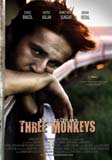
|
Three Monkeys
Peter Brunette, Hollywood Reporter, 16 May 2008
Patience will be required to appreciate this brilliant, gorgeously visual film.
CANNES -- It's no secret that the films of Turkish auteur Nuri Bilge Ceylan are an acquired taste. They are as slow as molasses, but as discerning cinephiles discovered with "Distant" (2003) and "Climates" (2006), what a sweet flavor that molasses, properly savored, contains. "Three Monkeys" is no different, yet at the same time represents some tentative steps into new and welcome thematic territory.
Low-grossing theatrical releases can be expected in major cities around the world in which the long-take aesthetic is still appreciated, and ancillary sales, especially DVD, will be even better. It's a must for festivals with even modest art-film pretensions and, given Ceylan's highly developed visual sensibility, should especially appeal to art museum programmers.
Ceylan's usual focus on individuals has now been expanded to include a family, comprising a husband, Eyup, a wife, Hacer, and their teenage son Ismael. Eyup, the driver of a local politician named Servet, is convinced by the latter to take the rap for a death caused by a driving accident on the eve of elections. His sentence will be short, Servet explains, his family will continue to be paid his salary while he's in prison, and a lump sum will be waiting for him when he gets out.
All of this backstory is conveyed by voiceover in seconds, then gotten out of the way as the film settles in to a leisurely exposition of the daily life of mother and son. Nothing whatsoever seems to happen, yet little clues are constantly being planted that will continue to build throughout the film and lead to several grand, if understated, emotional payoffs.
No one working in cinema today can suggest an interior psychological state, solely through the camera's external observation of an unmoving character, as well as Ceylan can. Also, he uses the entire frame, which is always perfectly composed for maximum expressivity, whether in a long-held extreme long shot, or in a devastating close-up. Differential focusing and camera angle are also meticulously thought out, and the emotional tension created in a few purposely drawn-out scenes can be excruciating.
The new territory, besides the emphasis on family dynamics, includes the occasional unnerving appearance of a long-dead younger brother, and several subtle feints in the direction of a apparently new religious sensibility.
The film is not without blemishes. For one thing, Hacer's motivation for a rash act that severely threatens the family is barely sketched in, hence not quite believable. For another, Ceylan seems unsure how to end his film, which would require a decision concerning which themes to accent.
But these are small cavils in the face of a film whose every shot seems lifted right off the wall of an art gallery and just as powerfully, if quietly, satisfying.
|

